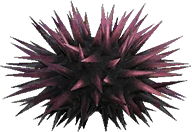Sea urchin
The sea urchin (ウニ, Uni) is a type of sea creature in the Animal Crossing series, introduced in Animal Crossing: New Leaf.
While initially absent from Animal Crossing: New Horizons, the sea urchin was added in the 1.3.0 Free Summer Update in July 2020, where it appears all day long as a small, slow shadow from late spring to early fall.
In August 2020, it became available as a limited-time item in Animal Crossing: Pocket Camp, where it is categorized as a shell rather than a sea creature.
Catch details[edit]
In New Leaf[edit]
| Time of year | May – Sep 15 All year (Tortimer Island) |
|---|---|
| Time of day | All day |
| Peak times | Jun – Aug |
| Shadow size | Small |
| Shadow movement | Stationary |
| Sea creature size | 12 cm |
| Rarity | Common |
| Selling price | |
| Furniture size |
In New Horizons[edit]
In New Horizons, a sea urchin is used as an ingredient in the fish meunière dish on Turkey Day in the southern hemisphere.
| Time of year | North: May – Sep South: Nov – Mar |
|---|---|
| Time of day | All day |
| Shadow size | Small |
| Shadow movement | Slow |
| Spawn requirement | Appears from the start of the game |
| Selling price | |
| Furniture size |
In Pocket Camp[edit]
The sea urchin appears as a shell in Animal Crossing: Pocket Camp and was available to collect for a limited time as part of the Sandy Shellfish Goals event, from August 20 to August 23, 2020. During the event, the shell would appear on the beach at Saltwater Shores, where it could be picked up. After the event, remaining Sea Urchins can stay in the player's inventory, where they can still be sold, used for animal requests, or listed in the player's Market Box. The sell price for this shell is ![]() 500 Bells. For villager requests, it is part of rarity tier 1, which earns the player
500 Bells. For villager requests, it is part of rarity tier 1, which earns the player ![]() 100 Bells and 2
100 Bells and 2 ![]() Friendship Points if the shell is used to fulfill a request.
Friendship Points if the shell is used to fulfill a request.
Donating to the museum[edit]
In New Leaf[edit]
Upon donating a sea urchin to the museum, it can be found in the large pool in the first room of the Sea exhibit, along with many other species of sea creature. It is found in the part of the pool closer to the entrance to the saltwater exhibit. The exhibit has this to say about the sea urchin:
In New Horizons[edit]
When donating to the museum, Blathers will say the following:
The sea urchin can then be found in the icy tank in the back, alongside the sea butterfly.
Fishing Tourney[edit]
In New Leaf[edit]
During a Fishing Tourney, when given a sea urchin, Chip will not score the sea creature but will say the following:
Gallery[edit]
Real-world information[edit]
Urchins typically range in size from 3 to 10 cm (1 to 4 in), although the largest species can reach up to 36 cm (14 in). They have a rigid, usually spherical body bearing moveable spines, which gives the class the name Echinoidea (from the Greek ekhinos, spine). The name "urchin" is an old word for hedgehog, which sea urchins resemble; they have archaically been called sea hedgehogs. The name is derived from Old French herichun, from Latin ericius, hedgehog.
Like other echinoderms, sea urchin early larvae have bilateral symmetry, but they develop five-fold symmetry as they mature. This is most apparent in the "regular" sea urchins, which have roughly spherical bodies with five equally sized parts radiating out from their central axes. The mouth is at the base of the animal; the lower surface is described as "oral" and the upper surface as "aboral".
More information on this topic is available at Wikipedia.
Names in other languages[edit]
| ウニ uni |
Sea urchin | |
| 성게 seong-ge |
Sea urchin | |
| 海胆 hǎidǎn |
Sea urchin | |
| 海膽 Unknown |
||
| Морской еж Morskoy yezh |
Sea urchin, lit. "sea hedgehog" | |
| Zee-egel | Sea urchin, lit. "sea hedgehog" | |
| Seeigel | Sea urchin, lit. "sea hedgehog" | |
| Erizo de mar | Sea urchin, lit. "sea hedgehog" | |
| Oursin | Sea urchin. Likely derived from "ours" (bear) and "hérisson" (hedgehog). | |
| Riccio di mare | Sea urchin, lit. "sea hedgehog" | |
| Sea creatures | |||||||||||||||||||
|---|---|---|---|---|---|---|---|---|---|---|---|---|---|---|---|---|---|---|---|
| |||||||||||||||||||






